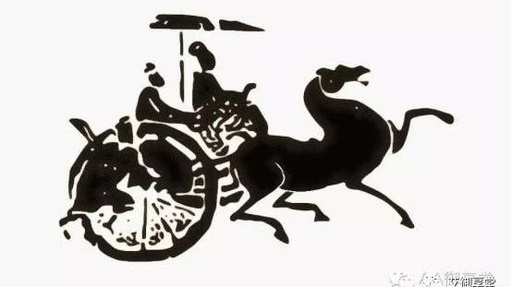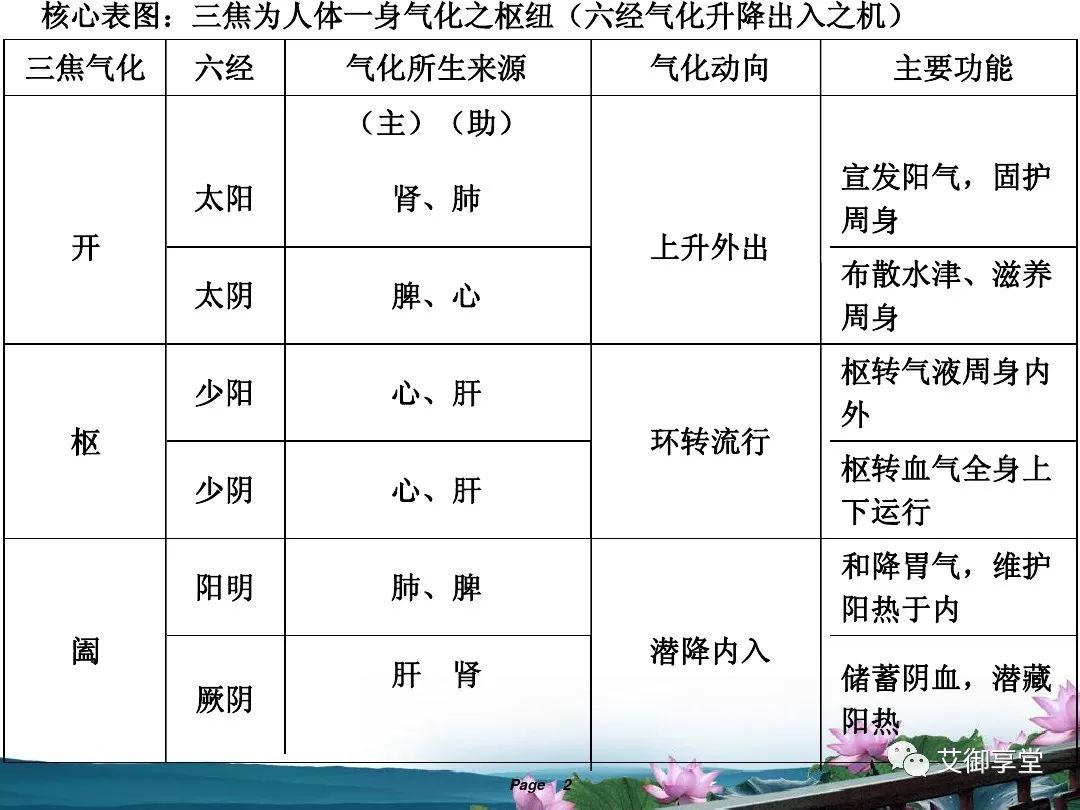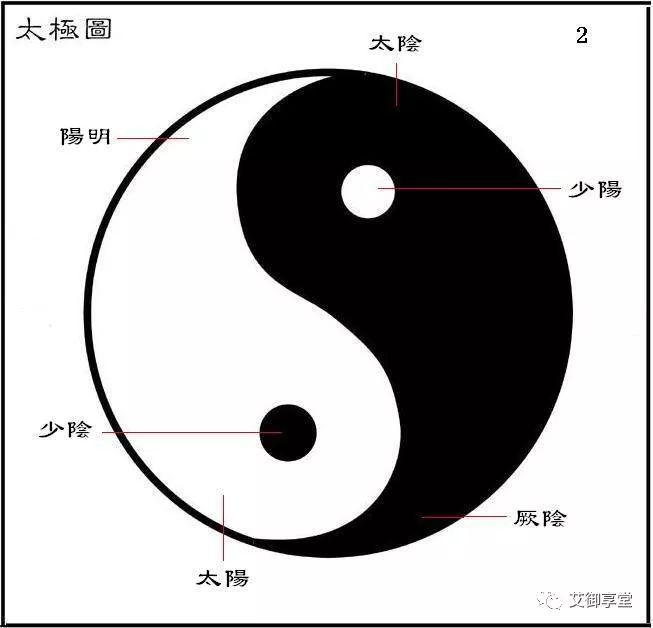Aiyu Xiangtang
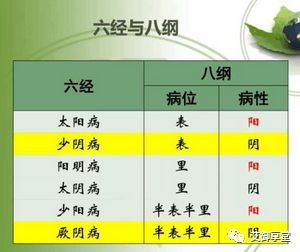
Author: Liu Duzhou
During the Ming and Qing dynasties, some outstanding physicians, such as Zhang Jingyue, Cheng Zhongling, and Jiang Bihua, extracted the two principles of Yin and Yang from the Six Meridians diagnosis to govern the differentiation of exterior-interior, cold-heat, and deficiency-excess, which was highly valued and welcomed by physicians at that time. Later, this concept was further developed and perfected, leading to the current Eight Principles diagnosis. From Jiang’s work “Differentiation of Exterior-Interior, Deficiency-Excess, Cold-Heat,” it can be seen that the terminology at that time only referred to Yin and Yang as principles, while the differentiation of exterior-interior, deficiency-excess, and cold-heat had not yet reached the level of principles.
Jiang stated: “All human diseases are nothing but Yin and Yang. The differentiation of Yin and Yang is inseparable from the six terms of exterior-interior, deficiency-excess, and cold-heat. The interior is Yin, the exterior is Yang, deficiency is Yin, excess is Yang, cold is Yin, and heat is Yang. A good physician saves people by merely differentiating these Yin and Yang; a mediocre physician harms people by misidentifying these Yin and Yang.” His statement is fundamentally similar to Zhang Jingyue’s concepts of “Two Principles” and “Six Transformations.” It can be said that this was the embryonic stage of the Eight Principles diagnosis system. Today, revisiting the development and clinical application of the Eight Principles diagnosis system is necessary for our reference and learning.
However, it must be pointed out that the thought of the Eight Principles diagnosis originates from the Six Meridians diagnosis in the “Shang Han Lun” (Treatise on Cold Damage). In the “Shang Han Lun,” the Six Meridians and the Eight Principles are closely linked and inseparable. This is because the Six Meridians are material, summarizing the organs and meridians, and differentiation must be based on this material foundation; thus, diseases cannot exceed the scope of the Six Meridians. However, the symptomatic manifestations of the Six Meridians cannot deviate from the rules of the Eight Principles differentiation, so the two must be combined to be effectively used in clinical differentiation. The specific methods of combining the Eight Principles diagnosis with the Six Meridians diagnosis are introduced as follows:
1. Yin and Yang
The “Nei Jing” states: “To treat a disease, one must seek the root; the root of life is based on Yin and Yang.” Therefore, the two principles of Yin and Yang serve as the principles of the Six Meridians and also as the principles of the Eight Principles, used to govern various symptoms and their developmental changes.
1. Taiyang Disease
Taiyang and Shaoyin are exterior and interior, respectively, and have a distinction of Yin and Yang. If the pulse is floating, with fever and aversion to cold, it indicates a disease occurring in Taiyang, known as Yang syndrome. If the pulse is deep, with no fever and aversion to cold, it indicates a disease occurring in Shaoyin, known as Yin syndrome.
2. Yangming Disease
Yangming and Taiyin are exterior and interior, thus having a distinction of Yin and Yang. If there is body heat with sweating, no aversion to cold, but aversion to heat, it indicates a disease occurring in Yangming, known as Yang syndrome; if Yangming is cold internally, turning to Taiyin, with inability to eat, difficulty in urination, cold sweating in hands and feet, and initially hard but later loose stools, it indicates a disease occurring in Taiyin, known as Yin syndrome.
3. Shaoyang Disease
Shaoyang and Jueyin are exterior and interior, respectively, and have changes in Yin and Yang. If a person experiences alternating chills and fever, fullness in the chest and flanks, irritability, and nausea, it indicates a disease occurring in Shaoyang, known as Yang syndrome. If there is deafness, contraction of the scrotum, inability to take in water, and a black slippery tongue coating, it indicates a disease occurring in Jueyin, known as Yin syndrome.
The Six Meridians diseases all have issues of both Yin and Yang. Viewing this with a perspective of oppositional development is called the dichotomy thought. If one can differentiate, one can discern, thus also governing the Six Meridians and clarifying the differentiation of exterior-interior, cold-heat, and deficiency-excess.
From the above, it can be seen that diseases of the Yang meridians often occur in the six fu organs, as the fu organs are Yang, with abundant Qi and blood, strong resistance to pathogens, thus characterized by various heat manifestations; while diseases of the Yin meridians often occur in the five zang organs, as the zang organs are Yin, with deficient cold Qi and blood, weak resistance to pathogens, thus characterized by various cold manifestations. Broadly speaking, any lightness of the body, shortness of breath, heat in the mouth and nose, clear eyes, inability to sleep; or extreme heat with blurred vision; or red eyes with excessive tears; or body heat with a red face and lips; or thirst with red-yellow urine, all reflect Yang syndrome. Conversely, if the body feels heavy, cold in the mouth and nose, unclear vision, a desire to lie down, pale complexion, cold extremities, blue nails, diarrhea, and white urine, all reflect Yin syndrome.
Ancient people said: “Extreme Yang resembles Yin, and extreme Yin resembles Yang,” so when differentiating between Yin and Yang syndromes, one must distinguish their authenticity to avoid being misled by their appearances. The “Shang Han Lun” states: “If a patient has a high fever but desires to be close to clothing, the heat is in the skin, and the cold is in the marrow; if the body is very cold but does not want to be close to clothing, the cold is in the skin, and the heat is in the marrow.” This indicates that the “syndrome” has authenticity, while the “condition” is credible. Therefore, one can observe the truth through “desire” and “non-desire.” In clinical practice, if one follows this method, they will be closer to the truth.
2. Exterior and Interior
The Yin and Yang of the Six Meridians diseases all have an issue of the site of onset. Therefore, recognizing the site of exterior and interior diseases allows for the appropriate use of sweating and purging methods.
1. Taiyang Disease Exterior and Interior Syndrome
(1) Taiyang Disease Exterior Syndrome: Among the Six Meridians diseases, only Taiyang disease can be considered an exterior syndrome, which is inseparable from the physiological characteristics of Taiyang. The Taiyang meridian connects to the Fengfu point, governing all Yang Qi, thus it governs the Six Meridians and regulates the defensive Qi, serving as a barrier outside the body, hence Taiyang governs the exterior. Additionally, each of the Six Meridians has its own meridian and fu organ distinction; when the meridian suffers from pathogens, compared to the fu organ, the meridian is external, thus having the meaning of exterior syndrome.
The “Shang Han Lun” states: “If both pulses are floating, it indicates a disease in Taiyang, which will manifest in one or two days. Because its pulse connects to the Fengfu, it causes headache and stiffness in the neck and back.” The symptoms in the first section of the “Shang Han Lun” stating, “Taiyang disease is characterized by a floating pulse, headache, stiffness in the neck, and aversion to cold,” all illustrate that the pathogen harms the exterior of the Taiyang meridian, leading to the characteristics of disease in the Taiyang meridian.
(2) Taiyang Disease Interior Syndrome: The fu organ of Taiyang is the bladder, located in the lower jiao. If the pathogen in the Taiyang meridian does not resolve, the pathogenic Qi follows the meridian into the fu organ, leading to water and blood retention. We call this the interior (fu) syndrome of Taiyang disease.
Taiyang Water Retention Syndrome: Characterized by a floating pulse, slight fever, thirst with a desire to drink, and difficulty in urination, even vomiting after drinking, this is called “water reversal.”
Taiyang Blood Retention Syndrome: In Taiyang disease, a weak and deep pulse reflects the exterior pathogen entering the interior, leading to hardness and fullness in the lower abdomen, and mental agitation; or urgent abdominal distension with mental agitation, yet urination is smooth, indicating heat and blood stasis, unrelated to water.
2. Yangming Disease Exterior and Interior Syndrome
(1) Yangming Disease Exterior Syndrome: The “Shang Han Lun” states: “If both pulses are long, it indicates a disease in Yangming, which will manifest in two or three days. Because its pulse connects to the nose and is linked to the eyes, it causes body heat, eye pain, and dry nose, making it impossible to sleep.” Cheng Wujis notes: “The Yangming pulse rises from the nose, connects to the eyes. The Yangming pulse, when it rises, returns to the eye system… Eye pain and dry nose indicate the presence of external pathogens in the meridian.” This syndrome also includes fever, aversion to cold, no sweating, a red face, and a headache, with a floating and long pulse.
(2) Yangming Disease Interior Syndrome: If the stomach and intestines are affected by pathogens, it is called Yangming Disease Interior Syndrome. The “Shang Han Lun” states: “After four or five days of cold damage, if the pulse is deep and there is shortness of breath, the deep pulse indicates the interior, and if sweating is induced, the fluids will be lost, leading to difficulty in defecation…” This refers to the interior syndrome of Yangming affecting the stomach and intestines. The interior syndrome cannot be treated with sweating; inducing sweating will harm the fluids, leading to difficulty in defecation.
3. Shaoyang Disease Exterior and Interior Syndrome
(1) Shaoyang Disease Exterior Syndrome: Shaoyang is half exterior and half interior, located in the two flanks, yet it also has exterior and interior syndromes based on the meridian and fu organ.
The “Shang Han Lun” states: “If both pulses are wiry, it indicates a disease in Shaoyang, which will manifest in three or four days. Because its pulse circulates in the flanks and connects to the ears, it causes flank pain and deafness.” Cheng Wujis notes: “Flank pain and deafness indicate obstruction in the chest and flanks, leading to dysfunction.” The “Shang Han Lun” also records that “Shaoyang wind causes deafness in both ears, red eyes, fullness in the chest, and irritability…” indicating Shaoyang meridian syndrome.
(2) Shaoyang Disease Interior Syndrome: This refers to the Shaoyang fu syndrome. The “Shang Han Lun” states: “The disease of Shaoyang is characterized by bitter mouth, dry throat, and dizziness.” This indicates that the pathogenic heat enters the gallbladder fu, forcing the bile to overflow, resulting in a bitter mouth, hence it is called the interior syndrome of Shaoyang disease.
4. Taiyin Disease Exterior and Interior Syndrome
(1) Taiyin Disease Exterior Syndrome: The “Shang Han Lun” states: “If both pulses are deep and thin, it indicates a disease in Taiyin, which will manifest in four or five days. Because its pulse spreads in the stomach and connects to the throat, it causes abdominal fullness and dry throat.” The “Shang Han Lun” states: “Taiyin wind causes pain in the four limbs…”; and “If Taiyin disease has a floating pulse, it can induce sweating…” all reflect the fact that the Taiyin spleen meridian is affected by exterior disease.
(2) Taiyin Disease Interior Syndrome: The “Shang Han Lun” states: “If it is originally a Taiyang disease, and the physician mistakenly purges it, leading to abdominal fullness and pain, it belongs to Taiyin…” This indicates that after a mistaken purging, the exterior pathogen enters the interior of Taiyin, resulting in abdominal fullness and pain in the Taiyin interior syndrome.
5. Shaoyin Disease Exterior and Interior Syndrome
(1) Shaoyin Disease Exterior Syndrome: The “Shang Han Lun” states: “If both pulses are deep, it indicates a disease in Shaoyin, which will manifest in five or six days. Because its pulse penetrates the kidney and connects to the lung, it causes dry mouth, dry tongue, and thirst.” This discusses the heat syndrome of the Shaoyin meridian. The “Shang Han Lun” states: “If Shaoyin disease is first acquired, and then there is a fever, with a deep pulse, it is treated with Ma Huang, Xi Xin, and Fu Zi decoction,” discussing the cold syndrome of Shaoyin meridian.
(2) Shaoyin Disease Interior Syndrome: This refers to the diseases of the Shaoyin heart and kidney. For example, the “Shang Han Lun” states: “In Shaoyin disease, if the pulse is deep, it should be urgently warmed, and it is appropriate to use Si Ni San.” Another section states: “In Shaoyin disease, if the pulse is thin, deep, and rapid, the disease is in the interior…” These two sections indicate that Shaoyin disease has both cold syndrome due to Yang deficiency and heat syndrome due to Yin deficiency.
6. Jueyin Disease Exterior and Interior Syndrome
(1) Jueyin Disease Exterior Syndrome: The “Shang Han Lun” states: “If both pulses are weak and slow, it indicates a disease in Jueyin, which will manifest in six or seven days. Because its pulse circulates in the Yin organs and connects to the liver, it causes fullness and contraction of the scrotum.” The “Shang Han Lun” states: “If the hands and feet are cold, and the pulse is thin and about to disappear, it is treated with Dang Gui Si Ni Tang.” The above two sections reflect the characteristics of heat and cold in the Jueyin meridian disease.
(2) Jueyin Disease Interior Syndrome: The “Shang Han Lun” states: “If a person has long-standing cold internally, it is appropriate to use Dang Gui Si Ni Tang with Wu Zhu Yu and Sheng Jiang.” “Long-standing cold internally” refers to the cold syndrome in the Jueyin organs.
In summary, we use the two principles of exterior and interior to reflect the diseases of the Six Meridians, which can embody the system and completeness of TCM differentiation. If we only discuss the interior syndrome of the organs without mentioning the exterior syndrome of the meridians, we lose the essence of the Six Meridians differentiation. Therefore, the Eight Principles diagnosis must be combined with the Six Meridians diagnosis to avoid being one-sided.
3. Cold and Heat
The two principles of cold and heat are established to reflect the cold and heat conditions of the Six Meridians diseases. They serve as the basis for differentiation in clinical treatment, as they encompass the specific conditions of exterior-interior and Yin-Yang diseases.
1. Taiyang Disease Cold and Heat Syndrome
(1) Taiyang Disease Cold Syndrome: Taiyang governs the exterior, yet there is a distinction between cold and heat in exterior diseases that cannot be overlooked. For example, the “Shang Han Lun” states: “In Taiyang disease, whether there is fever or not, there must be aversion to cold, body pain, nausea, and both Yin and Yang pulses are tight, which is called cold damage.” This reflects the characteristics of exterior cold as a disease, thus it can be called the exterior cold syndrome of Taiyang disease.
(2) Taiyang Disease Heat Syndrome: Where there is cold, there must be heat; this arises relatively. The exterior heat syndrome of Taiyang disease can be of two forms: one is the reception of warm pathogenic Qi, as stated in the “Shang Han Lun”: “In Taiyang disease, if there is fever and thirst, with no aversion to cold, it is a warm disease.” This indicates that the warm pathogenic Qi is still in Taiyang and has not fully entered the interior, thus it is called the exterior heat syndrome of Taiyang disease. The other is due to wind-cold binding the exterior, which, if unresolved for a long time, leads to cold stagnation transforming into heat, with the pulse changing from tight to relaxed, the body changing from pain to heaviness, and no sweating with mental agitation, which can also be called the exterior heat syndrome of Taiyang disease; additionally, the 27th section states: “In Taiyang disease, if there is fever with aversion to cold, more heat than cold… it is appropriate to use Gui Zhi, Er Yao, and Yi Tang,” which also belongs to the exterior heat syndrome of Taiyang disease.
2. Yangming Disease Cold and Heat Syndrome
(1) Yangming Disease Interior Cold Syndrome: Yangming governs the interior, and the interior syndrome is predominant. However, there is a distinction between cold and heat in the interior syndrome, as follows:
The “Shang Han Lun” states: “If there is virtual cold in the stomach, leading to inability to eat, drinking water causes belching.” This discusses Yangming interior cold causing belching. The 243rd section states: “If there is a desire to vomit after eating grains, it belongs to Yangming, and Wu Zhu Yu Tang is the main treatment.” This discusses interior cold causing vomiting and proposes a treatment method.
(2) Yangming Disease Interior Heat Syndrome: The interior heat syndrome of Yangming disease can be in the upper, middle, or lower parts. Heat in the upper part leads to vexation in the heart and tongue coating; heat in the middle leads to thirst and dry mouth; heat in the lower part leads to a floating pulse with fever, thirst, and difficulty in urination.
3. Shaoyang Disease Cold and Heat Syndrome
(1) Shaoyang Disease Cold Syndrome: The symptoms include fullness and oppression in the chest and flanks, difficulty in urination, thirst without vomiting, but sweating on the head, abdominal distension, and loose stools, with a wiry and slow pulse.
(2) Shaoyang Disease Heat Syndrome: The symptoms are primarily bitter mouth, irritability, dry throat, and dizziness.
4. Taiyin Disease Cold and Heat Syndrome
(1) Taiyin Disease Cold Syndrome: The “Shang Han Lun” states: “If there is diarrhea without thirst, it belongs to Taiyin, due to cold in the organs…” This indicates that the spleen has cold, thus the symptoms of diarrhea without thirst.
(2) Taiyin Disease Heat Syndrome: The “Shang Han Lun” states: “In cold damage, if the pulse is floating and relaxed, and the hands and feet are warm, it is in Taiyin. Taiyin should cause yellowing of the body; if urination is smooth, it cannot cause yellowing.”
Taiyin is damp earth, thus diseases can manifest as damp-heat and cold-damp, which must be clearly differentiated and not confused.
5. Shaoyin Disease Cold and Heat Syndrome
(1) Shaoyin Disease Cold Syndrome: The cold syndrome of Shaoyin disease is broad. The “Shang Han Lun” states: “In Shaoyin disease, if there is a desire to vomit but cannot, irritability with a desire to sleep, and after five or six days, there is diarrhea and thirst, it belongs to Shaoyin…” The white urine indicates that the lower jiao is deficient and cold, unable to control water, thus leading to white color.
(2) Shaoyin Disease Heat Syndrome: The “Shang Han Lun” states: “In Shaoyin disease, if it has been two or three days, with vexation in the heart and inability to sleep…” indicating the vexation of the heat syndrome in Shaoyin disease.
6. Jueyin Disease Cold and Heat Syndrome
(1) Jueyin Disease Cold Syndrome: The “Shang Han Lun” states: “If a person has long-standing cold internally, it is appropriate to use Dang Gui Si Ni Tang with Wu Zhu Yu and Sheng Jiang.” This indicates that the liver has long-standing cold, manifesting as cold accumulation in the lower jiao, cold pain in the lower abdomen, or reverse vomiting.
(2) Jueyin Disease Heat Syndrome: The heat syndrome of Jueyin disease can arise from receiving heat pathogens; or Yang Qi being constrained, transforming into heat over time; or excessive Yang in Jueyin leading to excess heat, as illustrated by the example of heat-induced Jueyin: The “Shang Han Lun” states: “In the first two to four or five days of cold damage, if there is Jue, there must be fever; if there is prior heat, there will be subsequent Jue. The deeper the Jue, the deeper the heat; the milder the Jue, the milder the heat. Jue should be treated with purging, but if sweating is induced, the mouth will be injured and become red.” This indicates that internal heat in Jueyin can lead to Jue.
4. Deficiency and Excess
The two principles of deficiency and excess often reflect the struggle between the righteous and the evil in the Six Meridians diseases. Generally speaking, diseases of the three Yang meridians are predominantly excess syndromes, while diseases of the three Yin meridians are predominantly deficiency syndromes.
1. Taiyang Disease Deficiency and Excess
(1) Taiyang Disease Exterior Deficiency Syndrome: Taiyang disease is an exterior syndrome; if there is sweating from the exterior syndrome, it is called exterior deficiency syndrome. For example, the “Shang Han Lun” states: “In Taiyang wind, if the Yang is floating and the Yin is weak, the Yang floating indicates heat; the Yin weak indicates sweating. If there is aversion to cold, aversion to wind, and fever, with a tight pulse, Gui Zhi Tang is the main treatment.” This discusses the deficiency syndrome of the exterior pathogen in Taiyang disease.
(2) Taiyang Disease Exterior Excess Syndrome: If there is no sweating but shortness of breath, it is called exterior excess syndrome. For example, the “Shang Han Lun” states: “In Taiyang disease, if there is headache, fever, body pain, back pain, joint pain, aversion to wind, and no sweating but shortness of breath, Ma Huang Tang is the main treatment,” discussing the excess syndrome of the exterior pathogen in Taiyang disease.
2. Yangming Disease Deficiency and Excess
(1) Yangming Disease Interior Deficiency Syndrome: Yangming governs the interior, and there is a distinction between deficiency and excess. The interior deficiency syndrome of Yangming disease, as stated in the “Shang Han Lun”: “In Yangming disease, if there is much sweating but no sweating, and the body feels like insects crawling under the skin, this is due to prolonged deficiency.” Cheng Wujis notes: “The stomach is the reservoir of fluids; if Qi is deficient and fluids are few, the disease will lead to no sweating. The stomach governs the muscles of the body, and if the body feels like insects crawling under the skin, it indicates prolonged deficiency of stomach Qi.”
Note: Taiyang governs the exterior, thus having sweating as deficiency and no sweating as excess. Yangming governs the interior, thus having sweating as excess and no sweating as deficiency, illustrating the differentiation of deficiency and excess between exterior and interior.
(2) Yangming Disease Interior Excess Syndrome: The interior excess syndrome of Yangming disease is characterized by “not changing clothes” and “difficulty in defecation” as the main clinical manifestations. The “Shang Han Lun” states: “The disease of Yangming is due to excess in the stomach,” discussing the characteristics of Yangming disease. The specific symptoms of interior excess include: no defecation, abdominal fullness and pain, or pain around the navel; or abdominal fullness that does not decrease, leading to inability to eat, with a deep and tight pulse, or a deep and strong pulse, with a yellow and dry tongue coating.
3. Shaoyang Disease Deficiency and Excess
(1) Shaoyang Disease Deficiency Syndrome: The deficiency syndrome of Shaoyang disease, as stated in the “Shang Han Lun”: “In cold damage, the Yang pulse is thin, and the Yin pulse is wiry; it should be treated with Xiao Jian Zhong Tang first; if there is no difference, Xiao Chai Hu Tang is the main treatment.” Shaoyang disease has a wiry pulse, but if it is taken as floating, it becomes thin; if taken as deep, it becomes wiry, reflecting the deficiency of Qi and blood in Shaoyang disease. First, use Xiao Jian Zhong Tang to support the deficiency of righteous Qi, then use Xiao Chai Hu Tang (which seems to remove Huang Qin and add Shao Yao) to harmonize the Shaoyang evil.
In today’s hepatitis patients, if they often experience persistent flank pain, and medication is ineffective, I often use Xiao Jian Zhong Tang with good results. This is the method of “the liver suffers from urgency, and sweet food is needed to alleviate it,” which has been used since ancient times, not just recently.
(2) Shaoyang Disease Excess Syndrome: This refers to Shaoyang disease with fullness in the chest and flanks, urgent pain in the heart, irritability, persistent vomiting, constipation, bitter mouth, and irritability, with a wiry and slippery pulse.
4. Taiyin Disease Deficiency and Excess
(1) Taiyin Disease Deficiency Syndrome: The deficiency syndrome of Taiyin disease often correlates with cold syndrome, as stated in the “Shang Han Lun”: “In Taiyin disease, if there is abdominal fullness and vomiting, inability to eat, and much diarrhea, the abdomen will hurt at times. If purged, there will be a binding in the chest below.” This fully reflects the vomiting and diarrhea syndrome due to spleen Qi deficiency and cold. However, in clinical practice, the cold syndrome of Jueyin disease is primarily characterized by vomiting, while the cold syndrome of Taiyin disease is primarily characterized by diarrhea, with vomiting being secondary; this must be understood.
(2) Taiyin Disease Excess Syndrome: The “Shang Han Lun” states: “If it is originally a Taiyang disease, and the physician mistakenly purges it, leading to abdominal fullness and pain, it belongs to Taiyin…”; “If there is severe pain, Gui Zhi plus Da Huang Tang is the main treatment.” This indicates that the excess syndrome of the spleen can be treated with purging. However, if the pulse is weak, it should not be used.
5. Shaoyin Disease Deficiency and Excess
(1) Shaoyin Disease Deficiency Syndrome: The deficiency syndrome of Shaoyin disease should analyze both Yin deficiency and Yang deficiency, as stated in the “Shang Han Lun”: “In Shaoyin disease, if the pulse is weak, sweating should not be induced, as it is due to Yang deficiency.” This indicates that the weak pulse indicates Yang deficiency, thus sweating should be avoided. The 285th section states: “In Shaoyin disease, if the pulse is thin, deep, and rapid, the disease is in the interior, and sweating should not be induced.” This reflects the deficiency syndrome of Shaoyin disease with a distinction between Yin and Yang.
(2) Shaoyin Disease Excess Syndrome: It is commonly said that “the kidney has no excess syndrome, and the liver has no deficiency syndrome,” which is a rough statement and insufficient as a guideline. However, how does the excess syndrome of Shaoyin disease arise? It often forms through the “middle organ leaking into the fu.” For example, the “Shang Han Lun” states: “In Shaoyin disease, if there is clear water diarrhea, pure green color, pain in the heart, and dry mouth, it can be purged, and Da Cheng Qi Tang is appropriate.” This indicates that internal dryness and heat lead to excess, which can affect the kidney, resulting in the excess syndrome of Shaoyin disease.
6. Jueyin Disease Deficiency and Excess
(1) Jueyin Disease Deficiency Syndrome: The deficiency syndrome of Jueyin disease can be divided into Yang deficiency and blood deficiency. For Yang deficiency, the “Shang Han Lun” states: “If there is profuse sweating, heat does not dissipate, internal urgency, pain in the limbs, and diarrhea with aversion to cold, Si Ni Tang is the main treatment.” This discusses the cold syndrome of Jueyin due to Yang deficiency. For blood deficiency, the “Shang Han Lun” states: “If the hands and feet are cold, and the pulse is thin and about to disappear, Dang Gui Si Ni Tang is the main treatment.” This discusses the cold syndrome of Jueyin due to blood deficiency.
(2) Jueyin Disease Excess Syndrome: The excess syndrome of Jueyin disease can involve phlegm obstruction and water retention, leading to heat accumulation that hinders the liver’s function, causing Qi stagnation and resulting in Jue. For example, the “Shang Han Lun” states: “If the patient has cold hands and feet, and the pulse is intermittently tight, the evil is obstructed in the chest, with fullness and vexation in the heart, and inability to eat, the disease is in the chest, and it must be purged, using Guo Ti San.” This discusses the phlegm evil obstructing the chest, leading to cold hands and feet in Jueyin disease. The 356th section states: “If there is Jue and palpitations in the heart, it is necessary to treat the water first, using Fu Ling and Gan Cao Tang, to treat the Jue. Otherwise, if water enters the stomach, it will definitely lead to diarrhea.” This indicates that water stagnation in the stomach hinders the liver’s function, leading to cold hands and feet due to internal water evil, thus it is called the excess syndrome.
Conclusion
Through the above combination of the Eight Principles diagnosis and the Six Meridians diagnosis, in each meridian, there are changes in the eight aspects of Yin and Yang, exterior and interior, cold and heat, deficiency and excess, reflecting the symptomatic rules of the Six Meridians diseases. Therefore, it has the significance of a guiding principle for differentiation. However, the Eight Principles diagnosis is also an objective reflection based on the diseases of the Six Meridians. Thus, the Eight Principles and the Six Meridians form a unified organic whole that cannot be separated. If they are artificially divided, it will inevitably destroy the material spirit of the Eight Principles diagnosis and the objective existence of the Six Meridians diagnosis.
At the same time, the differentiation theory of TCM is embodied in the physiological and pathological changes of the meridians and organs. Therefore, only by using the Eight Principles diagnosis method can we govern the diseases of the meridians and organs, the nature of the diseases of the Yin and Yang organs, as well as the cold and heat, righteous and evil, deficiency and excess, all of which are interconnected, allowing for clear understanding. For this reason, I humbly present the practical situation of combining the Eight Principles and the Six Meridians, discussing Zhang Zhongjing’s differentiation and treatment methods. Any omissions, please provide guidance.
Read more exciting contentThe nearly lost infant and toddler shonish therapyAnalysis and needling methods of the Eight Liao pointsRarely seen Japanese moxibustion illustrationsQing Dynasty’s twenty-four style massage classicsHuman meridian “Eight Types of Acupoint Characteristics Table”The three souls and seven spirits, see which ones are no longer with you?Hua Tuo and Zhang ZhongjingWhy is TCM difficult to learn?External heaviness leads to internal clumsinessWhy do classical formulas not mention “tonification”?Why is it called “Five Elements Theory” and not Four Elements or Six Elements?Should TCM diagnosis consider Western medical test reports?How to quickly learn advanced TCM“Waist and back are sought in the middle” – only effective if “correct”!“Jie Ji”: an ominous treatment

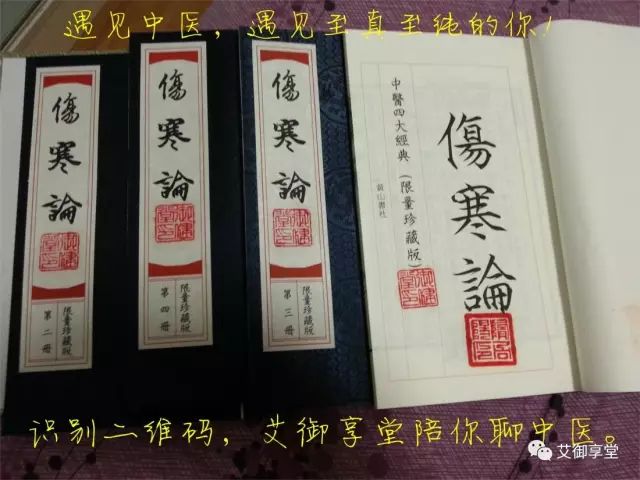
All information, except for signatures, is sourced from the internet, and copyright belongs to the original author.
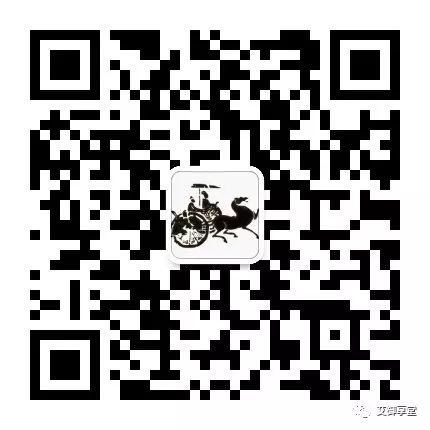 ID:hnbfdycx-ayc21w
ID:hnbfdycx-ayc21w
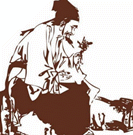
Aiyu Xiangtang

